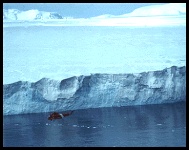
 This Shelf Could Hold a Lot of Stuff! An "ice shelf" is a floating ice sheet of considerable thickness that is attached to the coast. It usually extends far out over the water - which gives it a gently undulating surface. The shelf is nourished by snow falling on the top, water freezing at the bottom, and often also by the seaward extension of land glaciers. The seaward edge is termed an "ice front" and new icebergs can break away, or "calve", from the front of the shelf. Lying along the northern coast of Ellesmere Island in northern Canada, the Ward Hunt Ice Shelf is the biggest ice shelf in the Arctic. This vast region of ancient ice floating on the water is however, starting to break apart. Comparisions with the early 20th-century records of Arctic explorer Robert Peary show that there was much more ice than today. It is estimated that the ice has now retreated by about 90% since Peary made his observations. Retreating ice shelves may provide indications of climate change and the Ward Hunt Ice Shelf breakup comes at the same time as news of increased melting of sea ice in the Northern Hemisphere.
Click pictures for more information and credits. Library: Arctic, Glaciers, Icebergs, Snow, Ice Links: Ward Hunt Ice Shelf Arctic, Glaciers, Icebergs, Environment Arctic Maps & Weather Reports News Story: "Warning Signs in the Arctic" |

|
DICTIONARY: Just "double-click" any unlinked word on this page for the definition from Merriam-Webster's Student Electronic Dictionary at Word Central. |

|
ARCTIC LIBRARY & GLOSSARY: Check this section for an index of the rest of the things you really need to know about the Arctic. |

|
ARCTIC MAPS & WEATHER REPORTS: Maps of the Northwest Passage, explorers' routes, iceberg sources, Nunavut, the Arctic by treeline, temperature... |

|
ARCTIC LINKS: Even more information! Links to sites related to the Arctic and "Iceberg: the Story of the Throps and the Squallhoots". |

|
GUIDE TO ARCTIC SUNRISE & SUNSET: How much sunlight or darkness is there in the Arctic on each day of the year? |
to is the property of their respective owners, and Athropolis is not responsible for their content.